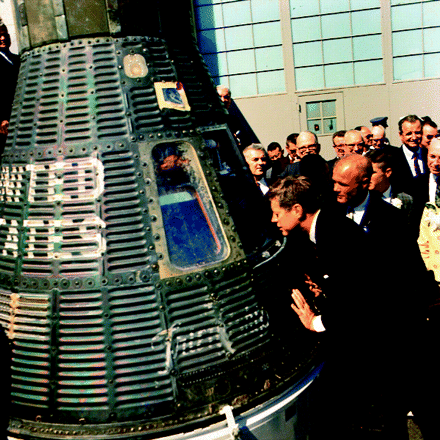Thomas Insel: How to Get Your Own Slice of the Mandala

Before becoming Director of the National Institute of Mental Health, Thomas Insel had consistently made fundamental contributions in both clinical and basic laboratory settings. But despite a slew of stellar research findings and professional advances, a peculiar circularity marks Insel’s career. The ideals and interests that arose during his youth have repeatedly surfaced in his work, a cyclicality that he has achieved by remaining mindful of the big questions: How do you make meaning of human experience? How do you bring compassion into the world? How do you compete with three accomplished brothers—all older, all MDs!—and get ahead? He is surprisingly open, comfortable with paradox, and appears to delight in eliciting new perspectives on familiar and sometimes onerous problems. Interviewed in the office he now occupies at the NIMH in Maryland—in the very locality where he attended high school—Insel tends to articulate responses that “close a circle,” “finish a loop,” or otherwise reinforce the sense of purpose he has maintained over the course of his work and life.
—Harry Smith
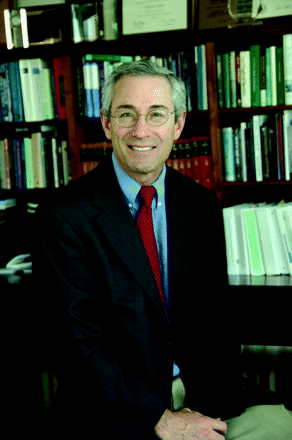
MI : Talk about how you first became interested in medicine and science. Did you come from a scientific family?
TI: Yes, very much so. I actually grew up in this area (Bethesda). My father moved here to join the new intramural program at the National Eye Institute in 1960. He had been in private practice as an ophthalmologist in Ohio when he moved the family to Maryland. He felt strongly that the future belonged to research, but he also found great joy in taking care of people. After about three months at the Institute, he decided to return to his eighteen-hour days as a private physician. But he truly felt that research was the way to make great advances. That was the Sputnik era, which had shown that we needed to be a more competitive society in terms of science. Jonas Salk’s big clinical trial in the mid fifties made a major impact as people saw the polio epidemic begin to fade away by the end of the decade. And with Kennedy’s arrival as President, there was just this huge wave of enthusiasm for research and public service. As a high school student growing up near Bethesda, I got to visit the NIH for lectures and lab presentations.
MI : Did you then pursue a medical degree with the idea of pursuing research?
TI: No, not at all. I was young when I left high school. When I was fifteen, I was accepted into a combined pre-med/med program, at Boston University. I decided to enroll at that time because I thought it would be the easiest way to get into medical school after college. But I was much more interested in liberal arts than I was in science at that point, and the best thing about entering BU through that program was that I was able to read very broadly. I was basically an English major, and since I knew I could go on to medical school as long as I kept up a C average, I took many different courses. I also took time off to travel. I hitchhiked across the country a couple of times, planning to write the great American novel. And then I went around the world, including a work experience that lasted for many months in a very remote hospital in India. There, in this very poor area of India, I watched young people die because we did not have the right treatments. That was when I made the real decision to go to medical school, and I matriculated with the idea of specializing in tropical medicine and eventually going back to India or some other area in real need.
MI : So what happened that took you off the course of tropical medicine?
TI: Well, we had a class in neuroscience during the first year of medical school, and I was blown away. I just thought the brain was really fascinating. The psychiatry course I had in my first year was kind of intriguing as well, and so when I needed a job to make some money at the end of the first year, I got an externship in psychiatry. I ended up going to Scotland for a summer and got paid to do clinical work in psychiatry. Tropical medicine faded into the background, and I took another year off and took some courses at Stanford University. I took a course in psychophysiology and a course in astronomy and a course in Kant—I really kind of covered the waterfront. I took some courses in Eastern religion, which I had become interested in while traveling.
Three passions, simple but overwhelmingly strong, have governed my life: the longing for love, the search for knowledge, and
unbearable pity for the suffering of mankind.
—Bertrand Russell
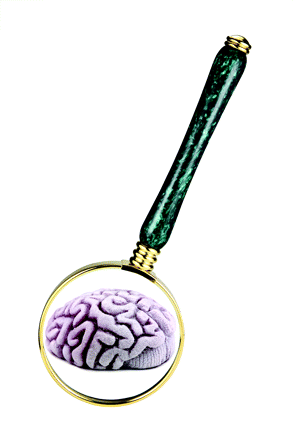
MI : You were pursuing a medical career, but you took time off to study astronomy, Eastern religion, and Kant? What was that all about?
TI: Well, it brings up a wonderful quote from Bertrand Russell, which I used to carry around in my wallet [see inset]. I very much had that experience [as quoted by Russell] at that age—still in my early twenties. I was lucky at an early age to find someone who has been my enduring partner in love, but I had both this tremendous fascination with trying to understand something about the nature of truth on the one hand, while on the other hand I saw the need to address the kind of suffering that I had seen in India. At the end of the day, I realized that neuroscience and psychiatry could bring some of these things together, which is why I went on to do a residency in psychiatry at UCSF. There, I had the chance to explore both aspects of this struggle: with patients who were suffering, as well as helping people find meaning from their struggle. The clinical work brought everything I was interested in together. I was also expected to undergo psychoanalysis as a resident, which was a great experience. Something I highly recommend to anyone who has the money, the time, and the inclination to be self-indulgent.
MI : Were you also thinking of becoming an analyst?
TI: There were twelve of us in the UCSF residency program. The other eleven (all males) wanted to become analysts, but I wasn’t sure, which made me the black sheep. Of all the twelve guys, I was clearly the low achiever. I was the one who never quite got it—I kept on asking to see data to support the concepts of psychoanalysis. It all sounded good, but I wanted to see the science. And then when my residency ended, I found myself, really as the result of an odd set of events, at the NIH, surrounded by people working to produce exactly the kind of data that I had been asking about all during my psychiatry residency. I returned to this area—where my wife and I had been in high school together—primarily for family reasons. I actually hadn’t known much about NIMH research, but at the end of May I found out about a clinical fellowship that started in June. So with two kids in tow and one dog and an old VW wagon, we moved back to Maryland. Within a month, I realized that I had finally figured out that I could be involved in finding the science I had been looking for. I saw that research was a very creative process and that the whole scientific endeavor could be brought into psychiatry. And it was happening here!
MI : You mean that here people were applying methods of science to study the mind?
TI: Well, people at NIMH were studying the biochemical basis of mental function. This was the grand era of neuropharmacology, and most of the senior people here, most of whom I had never heard of, were making important findings, the kind of findings that open entirely new fields of inquiry. I had had no training—no exposure as a resident to any of this. But I came here and I landed right in the middle of it!
MI : How did you react to landing amid the field and its practitioners? Were you as a novice able to approach them?
TI: There were a group of mentors—including Fred Goodwin, Richard Wyatt, Dennis Murphy—who were really smart, asking good questions, working very hard, and entirely accessible. It was just a very exciting place at an exciting time. Physically, it was a terrible environment to work in. My office was a converted seclusion room, shared by four of us, where we had desks, but no window or privacy. We would take call sleeping in an empty room on the inpatient unit in the hospital, kept awake by patients who were manic. But what an experience! It was an amazing period, and the amount of creative energy and scientific work that was getting done was fantastic.
And then the story comes full circle. I mentioned to you that I was the youngest of four boys in a competitive family with lots of idealism. And the message that I quickly learned, having three older brothers, was that you won’t succeed if you take the same path that everyone else has taken, because you can’t compete. You can’t run as fast; you’re not as big; you can’t play the same game. And you learn very quickly that if you want your piece of the pizza, you have to go to the other end of the pie. When I got to the NIMH, nearly everyone was working on depression, and to a lesser extent on bipolar disorder and schizophrenia.
So, I looked around and asked myself, “What is it that no one else is doing?” There was this illness called, in 1979, obsessive-compulsive neurosis, and it was kind of interesting, but nobody had studied it. And I thought it could be my way to get a foothold, possibly onto a path where nobody else had gone. Being at the NIMH, we were able to do the first randomized clinical trial of adults in the United States. With thirteen people who had classic forms of this disorder, we showed that medications really helped people with the disorder, contrary to popular expectation. One message that I would like to give to younger people is that the way to be successful in science is not to do what the vast majority of people do, which is to follow closely in someone else’s footsteps. To make discoveries, you have to try to go where people have not gone before.
MI : What treatment did you find to be helpful in OCD?
TI: We started with a serotonin reuptake blocker, clomipramine (Anafranil), which was not on the US market. It had been marketed in Canada and in much of Europe, and I remember having patients who were going to Haiti and to Canada to get it, which was already a hint that that the drug should be looked at. So we did a double-blind trial where we compared it to other drugs, and we knew right away that this was really something quite extraordinary. Patients who had been sick for many, many years became much better, whereas there was no effect from other antidepressants. And so it was the first observation that this subtype of antidepressant—one that inhibits serotonin reuptake—might have an application for the disease.
MI : Were the serotonergic aspects of mental disease known at that time?
TI: Not for OCD at all. It was thought about a lot for depression, but no one had really studied OCD. And the possibility of now making this a target for biomedical investigation just took off. I focused on OCD for about three or four years, wrote a number of papers, was invited to a lot of meetings, and then I got bored.
MI : What bored you?
TI: I couldn’t see a way forward. We had finished the most important studies to show that there was a serotonergic basis for OCD. At that time, in 1983, we still didn’t have the imaging capabilities that we know today. We didn’t have any other drugs to try. The work had gone very quickly and we made real advances, but the rest of it at that time just seemed to be footnotes. I was interested in opening up new areas—not in filling in the details of investigated areas. I got bored and so I dropped out. I wanted to do something completely different.
MI : And what did you think would be “completely different?”
TI: Neuroscience was really taking off, and molecular neuropharmacology and receptor pharmacology was on an absolute fast track. So, I did something that you can only do at the NIMH—I went to the scientific director and I said I wanted to change directions. I wanted to move beyond my limited credentials in clinical research. I wanted to become a basic neuroscientist. So, I changed careers again and went up to work with Michael Kuhar for a year at Johns Hopkins University. He was then pioneering receptor autoradiography, which I wanted to apply to neuropeptides. After that year at Hopkins, I started a lab at the NIH, where again I spent a whole year asking, “What’s not being done?” And I decided that I would like to understand the neurobiology of love. I knew it would take many years and many approaches, but the idea was to find out something fundamental about our social brain and our social experience. And the NIMH is such a crazy place, they allowed me to start a laboratory and take off with this! The field of social neuroscience didn’t exist then, but by doing a lot of reading and talking to a lot of people from different fields, my postdocs and I were able to put together a program of studies for this rather new research area.
MI : The breadth of this basic question is so striking—to go after love ! It brings up your earlier interest in Buddhism—did that have a role?
TI: Absolutely—and looking into compassion, understanding what this was really about. We first focused on parental care and the underlying neurobiology: What parts of the brain and what neurochemicals were involved for bonding a mother to an infant or an infant to a mother?

MI : What were your animal models at this time?
TI: We used marmosets, which are good models for maternal care, and we also worked a bit with rats and mice. We also brought in new species that hadn’t been used in the laboratory, such as field mice (Peromyscus). Because I really wanted to investigate the biology of the social bond—initially the bond between infants and parents but ultimately the bond between a male and female adult—the lab became heavily focused on monogamous species. After a colleague from the University of Maryland introduced me to monogamous voles, the lab spent many years looking into the neurobiology of social attachment in this species. We learned that the neuropeptides oxytocin and vasopressin seemed to have critical roles in attachment. Their receptors were key in mediating affiliative behaviors. A postdoc in the lab, Larry Young, who is now a Professor at Emory, found that changes in one particular part of the gene could direct the expression of the receptor in specific brain regions. If the animals didn’t have the receptor in the right brain area, they would not show social attachment. It was just a great story! The story continued to evolve, and is still evolving in Larry’s lab as well as other laboratories.
MI : The equation of neuropeptide signaling with love is of course meant as an oversimplification. But going back to your breadth of interests as a student—compassion, love, truth, religion—does the reductionism, or molecular characterization, of these grand issues undermine in any way the value you once placed on them?
TI: People have asked me that before, but really it’s just the opposite direction—for me, new knowledge doesn’t reduce the wonder or the mystery of anything at all. The word reductionism suggests a reducing of value, but for me, the closer you look at something, the more and more broad the mystery becomes. That may sound like a paradox, but it happens again and again. When you learn to use a microscope—it really opens up the world! It doesn’t really reduce it in a way one might think. And that has really been my experience in science all along. Who would think you could begin to understand something as complex as parental care by looking at brain circuitry and the expression of particular receptors in the brain?! And yet these investigations take you into all kinds of questions about evolution, about mate choice, about things like reciprocal altruism—a whole range of broad concepts get introduced when you take this kind of biological approach.
MI : You have written about the danger of “reducing brain imaging to high-tech phrenology.” I’m trying to reconcile this caveat with what you’ve just said and with what your research has produced.
TI: The brain is a vast information-processing machine with a very complex circuitry, and there’s no part of the brain that functions in isolation. What has concerned me about the use of neuroimaging is that people have tried to find a blob that they think represents complex mental experience. There are blobs that might be shown to be activated during complex mental experience, but there are going to be hundreds of thousands of them, and what isn’t lighting up may be incredibly important, because complex mental experience will likely require reducing the activation of certain areas. When you equate a bump on the skull or a blob on a scan with mind, you are practicing phrenology.
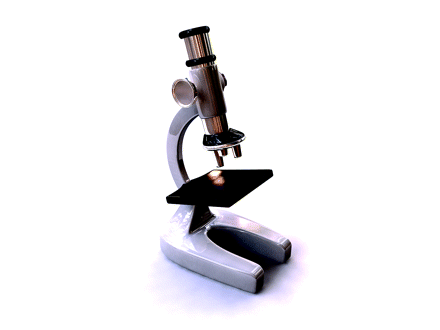
MI : How much of your role as Director of the NIMH entails having to sell a message like that? In terms of genomics and imaging, descriptions can sometimes suggest a linear walk from gene discovery to treatment.
TI: Well, for us [at the NIMH], our mission may be a bit different from other Institutes in that we are still very much in the business of trying to help people discuss real disorders. For years, and certainly when I was in training, there was a tendency to overlook any kind of biological basis for diseases such as schizophrenia or autism or bipolar disorder; these were regarded primarily as responses to adverse rearing conditions. Psychiatry has had a legacy of blame and shame. Today, we can discuss schizophrenia, autism, or bipolar disorder in biological terms, as physicians have for years been able to discuss cancer or heart disease or diabetes. And genomics and imaging are greatly helping us in teaching people about the biological bases for brain disorders. It really does make a difference now to identify specific circuitry—to show how certain circuits go off- or on-line as depression arises or subsides. It helps patients to know that these are symptoms—that the disorder is not their whole identity. And these discussions require us to work very closely with the advocacy community. I would definitely say that during my time as Director I have learned much more from the advocacy community than from anyone else. I probably feel as much of a connection to our patients and families as I do to the scientific community where I came from. And what’s happened to me most of all in these last five years is that I’ve come to realize that our families are the people we work for.
MI : In addition to shaping the discourse that applies to mental disorders, how are imaging and genomics going to change research and drug development?
TI: Above all, we want to use the power of neurobiology to take mental diseases entirely off the burden-of-disease map. Imagine a world without the suffering of schizophrenia or major depressive disorder! We are redefining the basic science of this Institute, bringing in new types of investigator and entirely new research tools. Genomics, proteomics, biomarkers—these are really going to be very important for our Institute and for the patients we serve. We are really at a stage that brings neurology and psychiatry together—it’s what I now call clinical neuroscience. We are learning how psychological experiences and psychological treatments can affect brain pathways. It has been fascinating to see, for example, that recovery from depression relies upon the same circuitry irrespective of whether treatment is based on medication or psychotherapy.
MI : What is it like, from your perspective of having left clinical work owing to a lack of data, to see such data now going to clinicians?
TI: It finishes a loop. After twenty years in the lab doing basic neuroscience, I had the same epiphany my father did when he came to the NIH to do research and then left to go back into practice. The research was so interesting and fun, and I was getting published and invited to give lectures around the world and so on. But in fact it wasn’t really making much of a difference to anybody. At about the time I was turning fifty, I began to go back to where I started and think about those days in India, wondering about the suffering masses, the reason that I became a doctor and why I started it all—the sentiments of Bertrand Russell were again at play in me. And just as I was having those thoughts, I was asked to look at this job as the Director of NIMH. And so I left my lab, changed careers again, and I became basically a full-time administrator. I have now spent the last five years trying to figure out how we can translate what we know about the brain and the mind in mental illness, to make a real difference for people with the most disabling developmental and mental disorders. How can we do the best science, from neurons to neighborhoods, to be able to make a difference in the world?
MI : It seems that each time you’ve been ready, the right job has come along—reminiscent of the proverb, “When the student is ready, the teacher will come.”
TI: I figure that I’ve changed careers about every five to ten years. I have no idea what the next one will be. I really can’t even imagine what it would be, because this has been the most interesting, by far. At NIH I feel I’ve had the greatest opportunity to have the greatest impact. This is really about changing the world. I said before that one of my messages for young people in research is to find a field that hasn’t been ploughed. Another message would be to be open to all kinds of new opportunities. I wasn’t looking for this job. I could never have imagined, ten years ago, that I would be here.
- © American Society for Pharmacology and Experimental Theraputics 2008
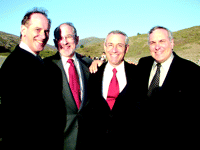
Four Insel Brothers, Four MDs (left to right) Jonathan, Richard, Thomas, and Paul

